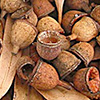Corymbia (Eucalyptus) citrodora (lemon-scented gum, blue spottedC gum, lemon eucalyptus) is a tall tree with a straight trunk which reaches to two-thirds of its height and which is characterized by a generally white bark which is sometimes lightly spotted. The crown is relatively sparse and broadens upwards. It is used in forestation for wood production for the manufacture of poles, for lumber and for hand tools. Its flowers are excellent as bee feders and its leaves are used for extraction of oil for medical and other purposes.
Since this is a beautiful and tall tree, it is used as an ornamental tree in parks and boulevards. It reaches a height of more than 40 m and its diameter can exceed 2 m. The bark is smooth, and somewhat powdery, white to pink or coppery, and sometimes spotted with gray spots.
The wood of lemon-scented gum is yellowish to brown, and even though it is hard, it is easily given to processing and making furniture. This makes this eucalyptus tree the preferred tree for wood production plantations in Australia.
The juvenile leaves are pilose, alternate. They are round to lanceolate. The mature leaves are alternate, narrow and long. The leaves contain groups of glands that secrete an essential oil which contains up to 98% citronellal. The concentration of this compound is high in young leaves and decreases with age. This substance has a strong lemony fragrance, which scatters when the leaves are broken, and which gives this species its name. The name of the species in Latin means “song of citruses”. Citronellal, which is used in medicine, in the perfume industry and for insect repellants, is extracted from the leaves of lemon-scented gum and from other plant leaves, including two other eucalyptus species.
Lemon-scented gum, like the entire family has bisexual flowers. The inflorescence, which is a raceme, has 3-15 flowers. The flower’s receptacle is semi-ovate and the operculum is shaped like a flattened cone, with a small protrusion at its center, and its base does not reach the tip of the receptacle. The stamens, which give the flower with its color, are white. The operculum is shed when the stamens straighten and push it outwards, when the typical flower, which lacks petals, is revealed. The operculum is the characteristic part and gives the genus Eucalyptus its name. The origin of the name in Greek is eu-kaluptos, which means “well covered”.
The tree blooms in the winter, in Australia in June-July and in Israel in November-December.
The fruits are shaped like a truncated ball whose ends face upwards and impart it with the shape of a vase or jug. It is 0.8-1.5 cm long and 0.7-1.2 cm wide. The seeds are small (118 per gram).
Following recent genetic and chemical studies, the scientific name of the tree was changed to Corymbia, which in Latin means “cluster”, apparently due to the shape of its raceme. Lemon-scented gum is endemic in the State of Queensland, in the North-Eastern part of Australia. The main concentration of trees is found at a distance of more than 300 km from the shore, in the region of a relatively dry plateau. In its natural habitat the climate is subtropical, with summer rains. The annual rainfall is 625-1,250 mm. The dry and cold winter lasts 5-7 months. The soil in which the tree grows is drained and slightly acidic. In its northern habitat it can be found up to an altitude of 800 m.
The habitat and the climate where lemon-scented gum grows naturally are completely different from those which exist in Israel, such that growing it here necessitates irrigation. This explains its lack of success in forests, as opposed to handsome and tall trees found in the cities and towns, especially in the Sharon and Center regions. A unique tree in size and handsome appearance is the old tree which was planted on Shapira Street in Petach Tiqua, which according to its measurement in 2004 reached a height of 35 m and a trunk circumference of 6.4 m. Conspicuous tall and handsome lemon-scented gum trees are also found on Herzl Street in Rehovot, opposite the Faculty of Agriculture, which are apparently remains of an acclimation plot that was planted there. Another six lemon-scented gum trees that reach a height of 20 to 33 m were counted in a survey of mature trees carried out by Israel Galon.
Lemon-scented gum belongs to the Myrtaceae family which includes 5650 species of evergreen woody plants in 130-150 different genera, where the most familiar of these are the myrtle, the guava, the feijoa and the callistemon. The genus Eucalyptus includes about 700 species and today it is the most commonly planted genus for wood production in commercial plantations around the world.
Written by Zvi Avni







